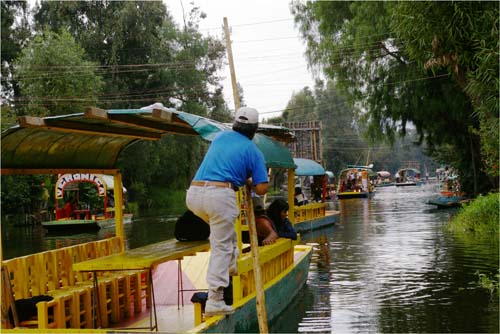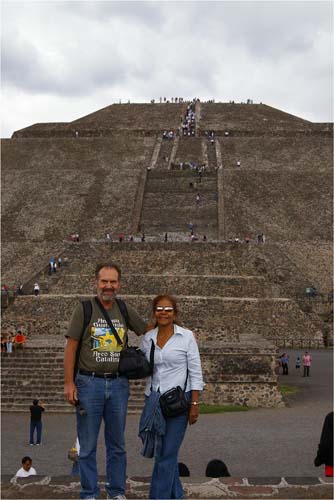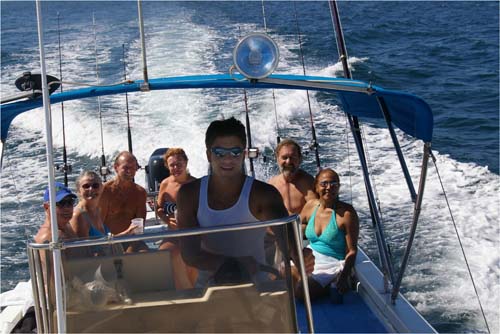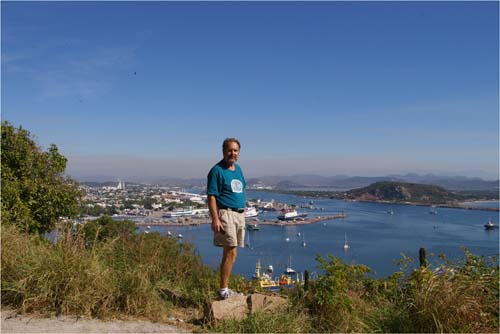At the outset here I am going to make a generalization.
Over the past 13 years I have been in Mexico and all
the countries of Central America,
interacting with officials and the local population in each one.
At the risk of alienating my Mexican friends, I must say that I find
Mexico
to be most like a police state and the most corrupt.
Read on.
As mentioned in the forgoing account, on August 21 I leave
the Sirius II on the Rio Dulce and
depart with Carmen by bus for
Quatemala
City.
We stay in The City for a couple of days, exploring and traveling to
Antigua, the original capital of Quatemala established by the
Spanish Conquistadores.

Venice-like canals in Xochinilco, near
Mexico City
Then, still by bus, we head for Los Mochis, crossing the border into Mexico at
Tapachula, where we stay over night.
Our next stop is Mexico
City. Here
we float in the canals in Xochinilco, the
Venice (Italy) of Mexico.
Then, we climb the monuments at Teotihuacan, some 40 kilometers NE of Mexico
City. This archeological cite
was inhabited from 100 B.C. to about 700 A.D. by pre Mayan and pre Toltec
cultures who built over time a huge, complex city with a central avenue
nearly 2 kilometers long.
(For a fictionalized account of the culture surrounding
this city, and others, including the monuments at Tikal mentioned in the narrative, I recommend
the Mel Gibson film “Apocalypse.”
It is a little violent at times, but otherwise quiet entertaining.)
During this time we encounter no difficulties with our
travel or hotel arrangements, nor with the military that stops all traffic
from time to inspect for……
Actually, I am never quite sure what they have in mind at these inspection
points. Sometimes they ask for
passports, but usually not.
Sometimes they appear to inspect the luggage, but usually not. They must
take a different attitude toward truckers. I
have seen on several occasions trucks lined up for miles, with diesel
engines polluting their air with their exhausts, waiting “inspection” while
all other traffic is waved on.

One of the monuments of Teotichuacan, near
Mexico City
The only peculiar twists: The taxi driver recommends a
hotel for us in Xochinilco that turns out to be a hotel for adults that
rents either by the hour or night!
That we stay for two days must have been an unusual experience for
the hotel workers. Also, I keep trying to tender a 2,000 peso bill that
vendors keep refusing. I assume
they just don’t want to make the change or they don’t think that I look
wealthy enough to have this much money (about $US200).
I later learn, after throwing an “ugly American” fit, that this
currency had been devalued years ago and is now worth about 2 pesos.
I must have had it in my stash of currency left over from a trip to Mexico years
ago.
In Los Mochis
I have a car waiting for me, a 1995 Subaru station wagon that I had
purchased in Arizona
in May during my short visit with Brother Mike and Char at their second home
in Scottsdale.
At that time, having previously purchased a round trip ticket to Ft
Lauderdale, I left the car in Los Mochis and took a bus to Phoenix to catch my flight to Ft Lauderdale.
Now I plan to drive back to Key West, with all of the boat parts brought
with me from the Rio Dulce. I
depart Los Mochis in late
afternoon and elect to do an all-nighter north to
Douglas,
Arizona, and
on to New Mexico.
Driving through Mexico I am stopped five times at
check points, not counting the border crossing, by various military, federal
authorities and who knows who else.
These check points have an assortment of armed personnel, usually
some in sandbagged foxholes. The
usual questions are where did you come from, where are you going, do you
have any fruit, and what is your nationality?
Into the dark of night and early morning the stops are longer and the
questions are more indistinct.
Finally, I ask one automatic-rifle-carrying soldier in the best Spanish that
I could muster: “What do you
want?”
In his best English that was decisively clear to me, his
response was “money!”
Well, I had suspected this all along.
My response to him, in English, was that I will not give him any
money. I could go to jail for
bribery or some such thing. I
place my wrists together as if in hand cuffs.
Finally, he throws up his hands in disgust and waves me through.
Crazy American, eh?
On my return trip, the station wagon is loaded with new
boat parts, a Honda Generator, various provisions and beverages, and, of
course, clothes for me. My plan is to
cross the border early in the morning, drive all day and night along the Gulf
Coast, cross to the Pacific side at the
Isthmus of Tehuantepec
, where Mexico
narrows to about 220 kilometers from the Gulf of Mexico
to the Pacific Ocean, to Tapachula and into Guatemala the
next day. Coincidentally, this
narrow isthmus allows for some very windy conditions generated in the Gulf of Mexico and blowing out to the Pacific where I have
previously sailed the Sirius II.
To take advantage of these winds,
Mexico
has installed extensive wind generator farms.
I cross into Mexico at Brownsville, Texas,
on the Gulf Coast.
I do not want to spend a night in Mexico in the middle of nowhere, for
reasons indicated below. My
research—basically a study of various road maps of Mexico—leads me to believe this is
possible. Wrong.
In Florida
I lost a day and a half of driving time in order to replace a leaking
radiator. Now I find it
necessary to spend a night in
Ciudad Victoria, just a few hours from the
Texas
border. From here I find the
Gulf Coast “highways” slow going, worse than secondary county roads.
Hills, curves, potholes and speed bumps, usually with no warning,
prevail. While signs are
adequate in the countryside, they are virtually non-existent in the towns
and cities. Again, traffic is
stopped from time-to-time for inspections.
At times it appears that agriculture officials initiate the stop to
look for the wrongful transport of fruits and vegetables.
But why are there soldiers carrying automatic rifles lurking in the
background?
Once again I am asked for money.
Once again I refuse. That
is, until Minatitlan in the state of Veracruz.
During the night, usually in the towns, I stop several
times to look at the road map to try to figure what road or street to take.
Since the map has such fine print, I find it useful to get out of the
car, walk in front, and use the beam of the headlights to read the map.
It is 3:30 a.m.
when I find myself in Minatitlan.
There is little or no traffic; no one to ask for directions.
While standing in front of the Subaru, a police car stops.
Two officers get out.
Great, I thought. Now I can get
directions to get back on the highway.
Wrong again.
These two were good.
While one keeps me busy with questions, the other makes a show of
walking around the car with a flashlight, distracting me.
“Amigo,” he says.
“Ven.” Come here.
He is at the front of the car pointing at the right headlight as if
there is a problem. I return to
the front and sure enough, the right headlight, which was on a few moments
ago for me to read the map, is not working!
How can that be? “Por
problema grande.”
Now we have an extensive conversation about how burdensome
a traffic ticket will be, how much it will cost to repair the light.
The one who speaks English reasonably well keeps asking me how much
money I have. I refuse to
answer, responding with “how much will the repair cost?”
Although I have heard many gruesome stories about Mexican
Police stations, I consider for a moment about insisting that I be taken to
El Jefe, their supervisor. But,
I don’t want to leave the Subaru unattended.
I have in the car thousands of dollars of boat equipment, my
computer, cameras and over $1,000 of American money that I have not
disclosed to my interrogators.
“I don’t have much money,” I keep repeating.
“Traveling in Mexico is muy caro.”
But you must have a credit card or a debit card.
All Americanos have debit cards.
Mistakenly, I allow that I do.
At this, the English speaking interrogator brightens up.
He escorts me to a 24 hour ATM.
He knows that I can withdraw 3,000 pesos (about $US300) and that
becomes the price of my freedom.
The ticket and repairing the light are forgotten.
It is interesting that the next time I stop to use the headlights to
read the road map, both headlights are working.
How did they do that?
I encounter no other significant problems traveling the
rest of the distance through
Mexico
and Guatemala
to the River Dulce. At the
border there is the usual nuisance of being surrounded by locals insisting
that I need their help in crossing the border, especially since I have a car
to register. Two hound me as I
go from one official to the next, but in the end I refuse to pay them as
they really do not help me through the steps.
Indeed, they don’t even advise me that the bank is now closed and
that I must return the next day to complete my paperwork.
What a nuisance!
While driving from one end of Guatemala to the other, including a
side trip to ruins at Tikal,
similar to Mexico,
Guatemalan officials stop traffic from time to time for inspections.
But these seem legitimate.
At no time here do I feel like I am being set up for a bribe.
My return trip to Mexico a month later is a repeat of
my previous experience. I check
with Mexican customs at the border to ensure that the Subaru is properly
registered for Mexico.
The official notices the sticker from Quatemala and waves me through.
I plot a course along the Pacific Coast
to Puerto Vallarta
where I am to meet Carmen Rosa and visit Brother Mike and Char.
After Puerto Escondito, the coastal route becomes a never ending
series of hills, curves, cutbacks and unmarked speed bumps.
At Acapulco I elect to take the autopista (which
is really an improved toll road) to
Mexico City, switch to the autopista to Guadaljara
and on to Puerto Vallarta.
Of course I get lost each time the autopista ends in a city and the
next one begins. Somewhere.
The last time this happens, as it is nearly
midnight, I elect to find a hotel and spend the night.
They are all filled up.
This is the weekend of November 19th, Mexico’s Revolution celebration.
While thusly preoccupied, I inadvertently go the wrong way on a
connecting street, right in front of a police car!
Of course you can imagine what happens.
This time there were three of them.
Without even a question about my passport or papers for the car, one
police officer who speaks no English begins ranting “Tickee, tickee.”
The other two are in conference.
Finally one approaches me to explain my options.
I could stay here until Wednesday, the next court date, or I avoid
the wait and the judge’s ruling and pay them now.
I am a little more alert than the last incident and we
finally agree on the payoff:
$US20. But only if they help me find a hotel.
Surprisingly, the English speaker agrees, although I sense that the “tickee”
officer still wants more.
Even they cannot find a hotel room for me.
I drive off in search of the autopisa while the other officer is
trying to make out with a private contact of some sort.
At last I find the autopista which terminates in
Guadaljara. This time I get
instructions from a truck driver at the last cuota (toll gate) and have a
pretty good idea of how to make the connection for the road to Puerto Vallarta.
It is now daylight and I notice that an American equivalent to a
state trooper has been observing this exchange.
Sure enough, within a minute I get the red and blue lights to pull
over.
For the first time I am asked about my papers for the car.
I point to the sticker from Guatemala on the
windshield and show him the paperwork.
He actually takes the time to read it and discovers that this permit
has expired. Three days ago.
I thought I had a 40 day permit whereas it was written for only 30
days. Oops.
My Florida
temporary permit had expired September 30th.
I was in Mexico with no valid permit for this
car. Or so it would seem.
How much would this infraction cost you in the United States,
he wants to know. About $10 was
my tongue-in-check reply. I
can’t let you drive in
Mexico
without a valid permit, he repeats several times, but for a little payment I
can let it go this time. He uses
the same approach as others: How
much money do you have? I admitt
to having very little money left after paying all the tolls for the
autopista. He seems to
understand this.
My story is that I have a proper permit for Los Mochis, which is where I am headed.
I stick to it. All of
this time the conversation has been in Spanish.
Now, after a conference with his partner, he reverts to English.
“How can you put up with all of the corruption in the United States,”
he wants to know. Startled by this
change of subject matter, my initial response is that I have never
experienced as much corruption anywhere as in Mexico.
Then I realize that what is needed here is not a debate about
relative corruption. I need to
find a diplomatic way out of this mess so I can continue my travels.
So I modify my statement to suggest that one can find some corrupt
officials in both countries.
Then I receive a lecture on his perception of US
corruption: US military intervention in Iraq; America’s policy
toward Cuba;
the treatment of minorities and Mexican immigrants in the United States.
Although I might be somewhat sympathetic with his examples, I hold my
tongue. Nothing is said about
public officials accepting bribes.
Finally, I offer him my last $US20 (in my wallet) as a
token of good will. Because he
feels sorry for me for being an American, or for being so broke, or both, he
waves it off and waves me on. I
think it has something to do with the fact that it is now daylight and what
is occurring cannot be covered up by the darkness of night.
Anyway, I go.

In Puerto Vallarta with Mike and Char, sitting
aft, two of their PV friends on the starboard side and Steve and Carmen on
the port
I encounter no other unpleasantries the rest of the way
to Puerto Vallarta.
I meet Carmen at the bus station and together we track down Mike
and Char at their “fractional” (a unit they own for a fraction of a
year). Of course we do some
golfing, take a boat ride (Islas Marietas, near the northern entrance to
the Bay of Banderas where Puerto Vallarta is located), do some sight
seeing and eat a lot. We even
squeeze in a televised Seahawk game and a visit a few miles south of the
city to the Hotel Zone where “The Night of the Iguana” was filmed.
Now I feel an obligation to see the movie.

The harbor at Mazatlan from the base of
the lighthouse
Following this enjoyable visit, Carmen and I
motor to Mazatlan for a few days before we complete our journey to Los
Mochis.
A follow up on the headlight malfunction:
During the drive from Acapulco to Guadalajara, I noticed that the left
headlight was not working when the switch was on dim.
Soon it would again work but then the right one would malfunction.
I checked the system in Puerto Vallarta and noticed that the
electrical plug connections to both headlights were showing signs of over
heating. I had them both
replaced for 70 Mexican pesos, about $US7, and have not had a problem since.
As to the letters you can read in the next Appendix, it
has been four months since I sent them.
I have yet to receive a response.



